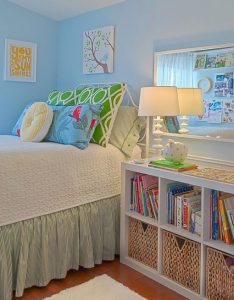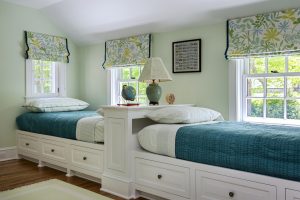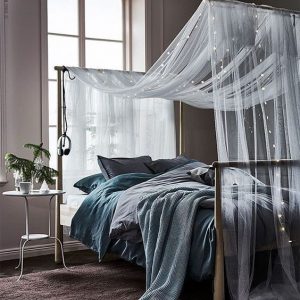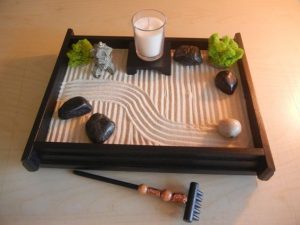What is mindfulness? Simply put, it’s the ability to be fully present, aware of where you are, what you’re doing, and have conscious control over your thoughts. A daily mindfulness practice can increase your happiness, improve your well-being, reduce stress, increase focus, improve memory, and build resilience. As you create space for living mindfully, you’ll foster the ability to thoughtfully respond rather than having a knee-jerk reaction to whatever is going on around you.
Creating an Intentional Environment
It’s much easier to foster a daily practice of mindfulness when you live and work in an environment that supports what you want to attract and experience in your life. I’ll offer a few tips to help you intentionally create your environment:
Set an intention.
 Just as you set goals for your life, you can create an intention for each space you work and live in. Once you’re clear about what you want, you can create a physical space to support that. Living and working in an intentionally-designed space will help you to make better decisions and reduce the amount of time and money you waste.
Just as you set goals for your life, you can create an intention for each space you work and live in. Once you’re clear about what you want, you can create a physical space to support that. Living and working in an intentionally-designed space will help you to make better decisions and reduce the amount of time and money you waste.
To set an intention, identify how you want to feel. For example, if you want to create a space in your bedroom that helps you relax, you might choose soft colors that create a serene and peaceful space. If you want to create an office or work space that stimulates your creativity, you might chooser brighter and bolder colors. A Google search for the meaning of colors will help you source a number of sites on the subject. I found a good one here.
Choose your furnishings and lighting to support the way you want to feel in that space. Also choose fabrics that support the activities that will take place in that space. For example, if you have children or pets, it may be helpful to choose furnishings that are easy to clean and are stain-resistant.
Heighten awareness of your senses.
Pay attention to your surroundings and your sensory responses to each environment where you spend time. Do this by observing and tracking your movements and activities in the space you want to improve. Write down what you experience, taking note of what you like and what you don’t like.
For example, if you want to make improvements to your office, pay attention to the physical sensations you feel while sitting in your office chair. Is it comfortable and supportive? Does the office lighting support your work, or do your eyes feel strained? Is the air stale or fresh and well ventilated? Is it too warm or too cold? Do you enjoy the sounds you hear in your office? Do you feel inspired by the colors and what’s hanging on your walls? By connecting to your senses, you can make meaningful changes that support the way you want to feel when you are in that space.
Once you’ve written down your sensory observations, take action to make changes and improvements on the things you don’t like.
Clear the clutter.
Once you’ve taken inventory of all of your senses and how your space makes you feel, declutter the space. This requires you to let go of things that no longer enhance your life, arranging the remaining things to support you in accomplishing the activities you intend to do in that space.

Kathy Paauw's definition of clutter: anything you own, possess, or do that does not enhance your life on a regular basis.
I’ve written many articles on the topic of clutter, and you can find them on my website by clicking on the eyeglass search button and typing in the word “clutter.”
Perhaps you think that you must wait until you can move to another office or home in order to enjoy your space. The good news is that, in most cases, you don’t have to move to create an enjoyable environment. With some intention and mindfulness, small changes can yield big results in how you feel about the space where you currently work or live.
The article below — written by Erin, a Lifestyle Blogger at American Freight Furniture and Mattress — provides great suggestions on how to put these ideas to use in a bedroom. It serves as a good example of how to pull all of these ideas together to create space for living more mindfully.
How to Decorate a Tiny Bedroom
Your bedroom should be a place to relax and restore after a long, hard day. But if you’re living in a home with a small bedroom, it can be hard to make the space feel serene while storing all your belongings. It can be hard to find a balance of keeping a tiny bedroom neat without overcrowding the room. We have some great ideas to keep in mind to help you decorate your small bedroom. Let’s dig in!
Cut Back on the Clutter
This may seem fairly obvious, but the reason a lot of people struggle with small bedrooms is because they try to fit too much into the space. The best thing to eliminate or reduce is decorating accessories. If they don’t provide storage or if they take up too much space, they would probably be better off in a living space. You can also donate or sell that décor and use that cash to buy dual-purpose accessories that look great and store your stuff.
We like to recommend jewelry boxes, small trays, or stationary containers to decorate your room. As for the stuff you already have, if you haven’t used it (or noticed it was there) in the last year, it might be the perfect time to part ways.
 Choose Bright Colors
Choose Bright Colors
Dark colors can make a room feel even smaller than it already is, so it’s important to make sure you’re choosing lighter, neutral tones that will help open up the room and make it brighter. Pastels, whites, tans, and light greys are perfect for the walls. You don’t have to stray from dark or bold colors completely, though. Choose them for accents like lampshades, throw pillows, or accessories.
You could also play with a paint pattern. Try a light gray or white wall with a dark striped accent wall. Or add a pop of color by painting the trim and crown molding a bright color that will tie your accents into the space.
Pick the Right Furniture
If you’re purchasing new furniture for this room, there are a few things you’ll want to keep in mind. First, make sure you take measurements of the room first so you know what will and will not fit.  Next, consider the size of the bed: a large bed will make your room feel tight and cluttered, and it will not leave room for other furniture items. Instead, consider the different mattress sizes available and see which will work best for you and your space.
Next, consider the size of the bed: a large bed will make your room feel tight and cluttered, and it will not leave room for other furniture items. Instead, consider the different mattress sizes available and see which will work best for you and your space.
You’ll also want to consider furniture that will maximize your wall space. Try to steer clear of furniture that is built with a curve. Finally, check out furniture that comes with built in storage in convenient places like a storage bed or a headboard with built-in shelving. These will give you somewhere to store items without taking up valuable space in your room.
Create a Focal Point
 A main focal point in a small bedroom can really bring everything together. The focal point can be whatever you choose – some people go for a bold, bright painting that really makes a statement, while others go for an elegant piece of furniture like a canopy bed. Remember that whatever you choose as the focal point will be the main element in the room, so you’ll want to decorate with it in mind.
A main focal point in a small bedroom can really bring everything together. The focal point can be whatever you choose – some people go for a bold, bright painting that really makes a statement, while others go for an elegant piece of furniture like a canopy bed. Remember that whatever you choose as the focal point will be the main element in the room, so you’ll want to decorate with it in mind.
Make the Ceiling Pop
Another way to really open up the room is to add some interest to the ceiling. There are many different ways to do this depending on what your particular style is. Some people choose to paint the ceiling a different color than the rest of the room to add color or texture. You could also add architectural elements like beams, panels, or crown molding for detail. If you’re really looking to go bold with a pattern, you could choose a wallpaper that works with your decor and wallpaper your ceiling.
Having a small bedroom doesn’t mean it can’t be the relaxing getaway you need after a long day. Keep in mind these simple tips, and a small space can still feel big.
Foster Mindfulness with a Zen Garden
 Another way to foster mindfulness is to create a Zen garden. These special areas were originally created in Japan to assist Zen Buddhist monks with daily meditation and introspection. Although we may not have the time and space to create and maintain a traditional Zen garden, we can still engage in this practice and reap the benefits by creating our own mini Zen gardens.
Another way to foster mindfulness is to create a Zen garden. These special areas were originally created in Japan to assist Zen Buddhist monks with daily meditation and introspection. Although we may not have the time and space to create and maintain a traditional Zen garden, we can still engage in this practice and reap the benefits by creating our own mini Zen gardens.
Click here to check out some instructions on how to create a mini Zen garden.
If you’d like a fresh perspective–someone to help you clarify priorities and create a mindful and supportive space—let’s schedule a no-cost, no-pressure Discovery Call today.
Additional Resources:
- Blog: Declutter Your Life
- Blog: What Does Clutter Cost You?
- Blog: How to Declutter Any Space
- Blog: Hidden Clutter
- Blog: Balance Your Life: Environment #8 – Physical











It’s an incredible article and steps to make our life better taking the decision of simple actions and consistent habits.
A loft conversion can be an inexpensive, creative, and a straightforward way of improving the living space which also swells property’s worth. Combinations of both light and darker colors can be utilized to acquire a classy look. Stay minimalistic and prevent making your own home seem like a showcase.
Kathy,
A great blog on Mindfulness. You seem to have a happy knack of creating a blog when it’s top of my mind also. Is this the Law of Attraction in action? I think so!
One of my Coronavirus projects is to transform my office space from a work office to an office that enhances my retirement. I have been working from home for 22 years! There is much to toss. All of these articles have helped me create focus, see possibilities, identify what I need to add (a better reading lamp and some softness; have to buy these things later), and knock me out of the “work office” mindset. Thank you Kathy!
Andrea, I am so happy to hear that my blogs are helpful to you. Good job!